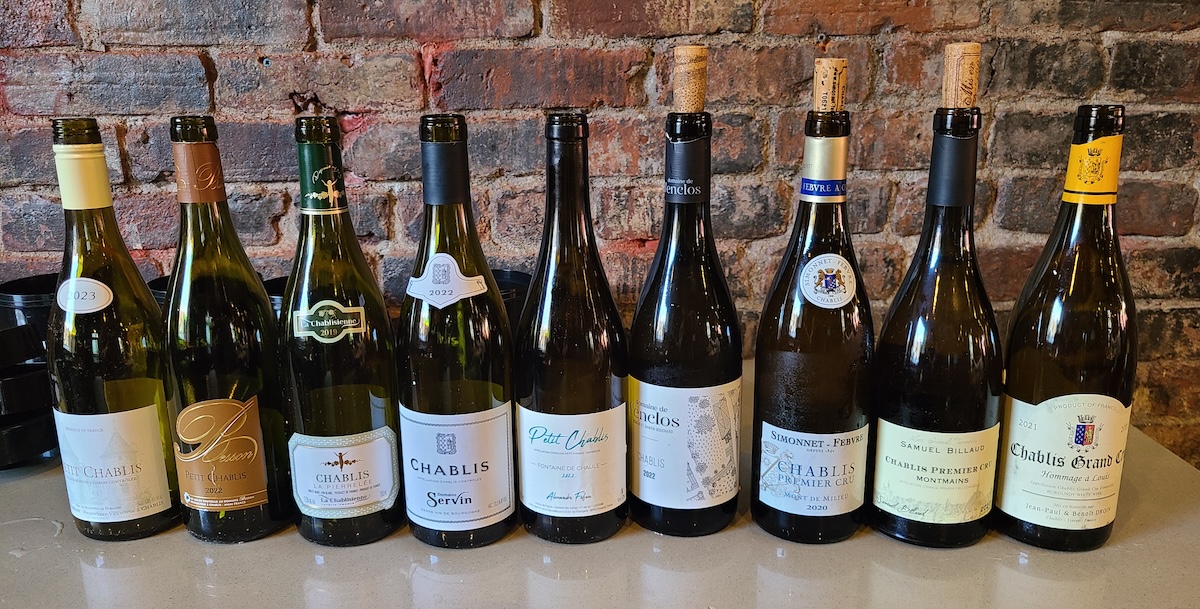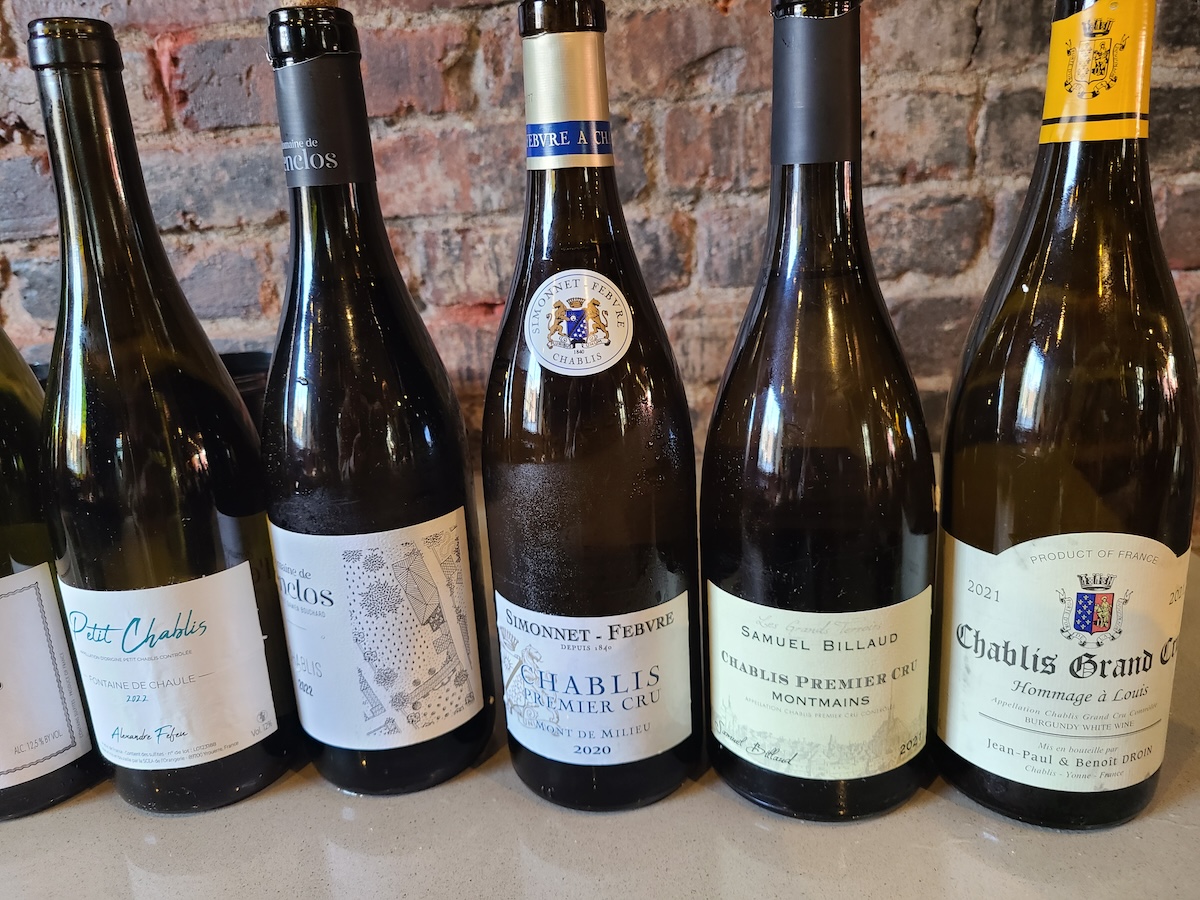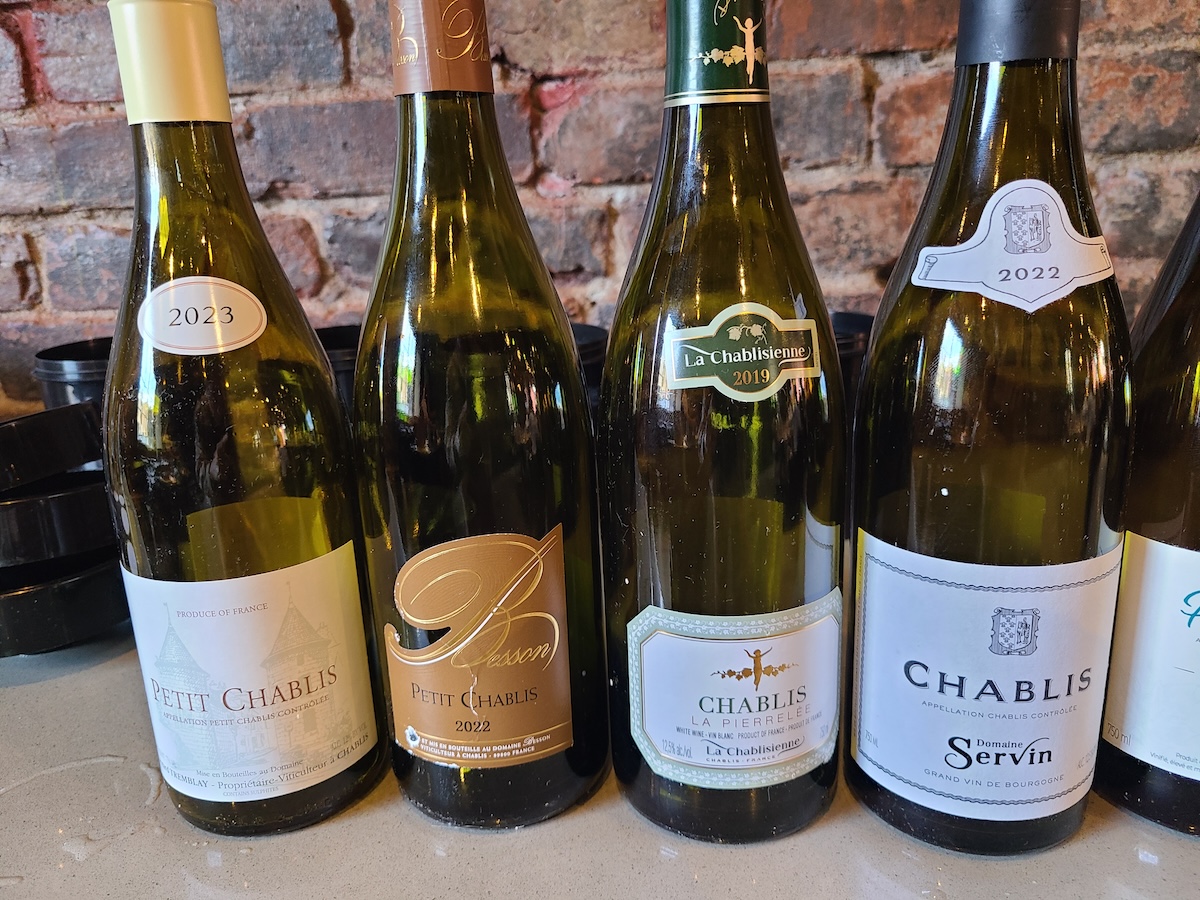Nestled in the northern part of France’s Burgundy region, Chablis is renowned for its distinct and highly esteemed white wines. The region’s unique terroir, coupled with centuries of winemaking tradition, contributes to the exceptional quality of Chablis wines. I was invited to attend a Trade Tasting of Chablis wines, held at L’Abbatoir restaurant in Gastown. We had wonderful wines and delicious paired dishes.
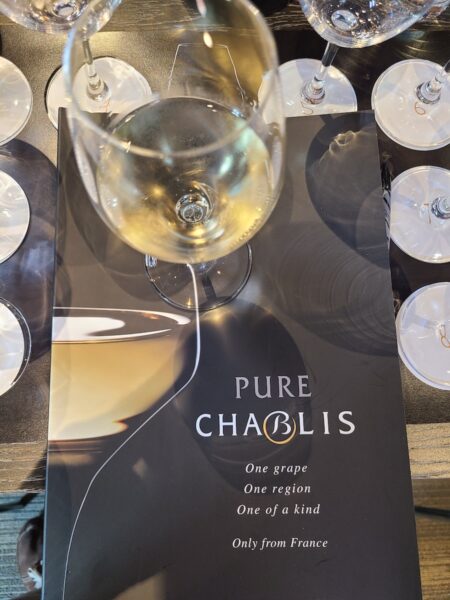
Our speaker was Mark Shipway, DipWSET, Director of Education & Training for Christopher Stewart Wine & Spirits Inc.. He is also a Bourgogne Wines Ambassador for western Canada. Mark introduced us first to Chablis, taking us through the key appellations and what makes them unique. Following, he lead us through a blind wine tasting, pairing two wines with a dish prepared by L’Abbatoir.
What sets Chablis apart is its unique terroir. The region’s soils are rich in limestone from the Kimmeridgian period, around 150 million years ago, when Chablis was submerged under a shallow sea. These soils, rich with fossils of small oysters called Exogyra virgula, impart a distinctive mineral quality to the wines. The cool climate of Chablis helps maintain a perfect balance of sugar and acidity in the Chardonnay grapes, leading to the region’s renowned purity and sophistication in its wines.
Let’s review the four key appellations of Chablis and what makes each one unique, followed by the blind tasting and food pairing.
Petit Chablis: Fresh and Crisp
Petit Chablis represents the entry-level of Chablis wines, covering an area of approximately 1,150 hectares (2,840 acres). This appellation is typically planted on the plateaux of hillside vineyards where it is exposed to winds. The soils are also more likely made from the harder Portlandia limestone. Stainless steel fermented, these wines are characterized by its freshness and crispness. Petit Chablis is often enjoyed young. Its flavour profile usually includes aromas of fruit and white flowers, with hints of minerality. This style of wine offers a delightful introduction to the Chablis region’s celebrated character.
Chablis: Structured and Versatile
The Chablis appellation is the largest of the four, encompassing around 3,700 hectares (9,140 acres) with soil made from softer Kimmeridgian limestone. The vineyards within this appellation are scattered throughout, on a variety of slopes and orientations. Chablis wines are known for their stronger structure and greater length on the palate compared to Petit Chablis. They are made from the same Chardonnay grape but exhibit a more pronounced complexity. The wine’s aptitude for aging allows it to develop additional depth over time.
Chablis Premier Cru: A Tapestry of Styles
The Premier Cru appellation, covering approximately 790 hectares (1,950 acres), represents a higher tier of quality within Chablis. This level is distinguished by its 40 different climats, or specific plots of land, each with unique characteristics, A plot does not necessarily mean a single vineyard. It could be a portion of a vineyard or could cross over to encompass parts of different adjacent vineyards. Some climats, like Montée de Tonnerre and Côte de Léchet, are known for their vibrant, mineral qualities with flint-like flavours, while others, such as Beauroy and Montmains, are more delicate and fruity. The diversity among these climats allows for a wide range of styles and expressions, offering a more nuanced exploration of Chablis’s terroir.
Chablis Grand Cru: The Pinnacle of Excellence
At the top of the Chablis hierarchy is the Grand Cru appellation, which includes just 102 hectares (250 acres) divided among seven climats: Blanchot, Bougros, Les Clos, Grenouilles, Preuses, Valmur, and Vaudésir. This appellation is located to the north of the town of Chablis and is primarily on a southwest facing slope. Each climat in the Grand Cru category has distinct features. For instance, Blanchot is known for its floral, supple qualities, while Les Clos is revered for its powerful and mineral characteristics. Valmur offers a balanced blend of fruitiness and minerality, whereas Grenouilles is celebrated for its rich and charming profile. Each Grand Cru climat has exceptional aging potential, providing wines that are both complex and refined.
The Blind Tasting and Dish Pairing
As mentioned, the wines were served blind to us. The bottles were poured as they were wrapped in bags, so we had no idea about them. The wines and dishes:
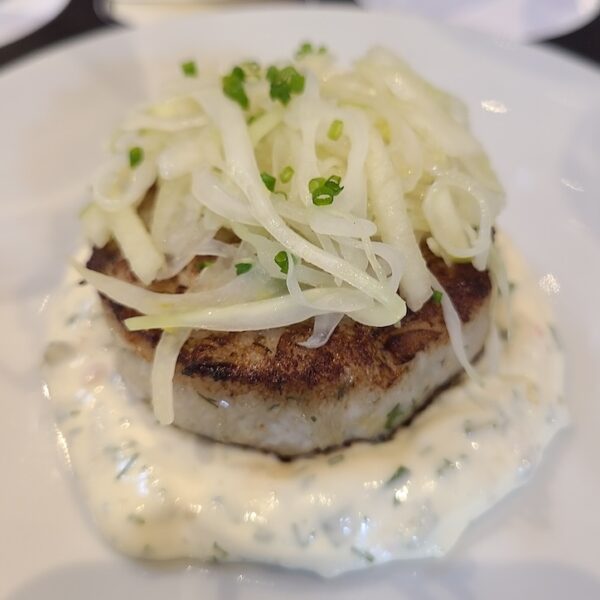
Domaine Besson Petit Chablis 2022 – a wine with deeper lemon colour. Medium intensity nose with flint and pineapple. Lighter body, soft mouthfeel. Light citrus, pineapple and a touch of sweet spice. Light pepperiness toward the finish. Medium length.
La Chablisienne La Pierrelee Chablis 2019 – A deeper, slightly dull lemon colour. Lighter flinty and citrus aromas. Medium-plus body, with a thicker, round, viscous mouthfeel. Crisp apple, citrus rind flavours, plus touches of minerality and honey. Medium length.
Both wines made a complementary pairing with the dungeness crab cake. I enjoyed the creaminess, dill and fennel flavours, and the slight saltiness of the dish. In my opinion, the acidity of the Petit Chablis and its lighter flavours was a bit nicer pairing with the dungeness crab cake.
Alexandre Fefeu Fontaine de Chaule Petit Chablis 2022 – A lighter clear straw colour with green tint. Light tropical fruit and toast aromas. Dry with higher acidity and lean mouthfeel. Tart apple, apple skin and some grape stem bitterness. Acidic prickle on the tongue. Also light pepperiness and a touch of butterscotch. Bright flavours. Medium length.
Domaine Servin Chablis 2022 – A deep intense lemon colour. Medium intensity aromas of stone fruit and tropical fruit. Medium-plus body with round, smooth, thicker mouthfeel. Stone fruit, apple and light flintiness. Light acidic prickle. Medium length with some bitterness and dried stone fruits flavours on the finish.
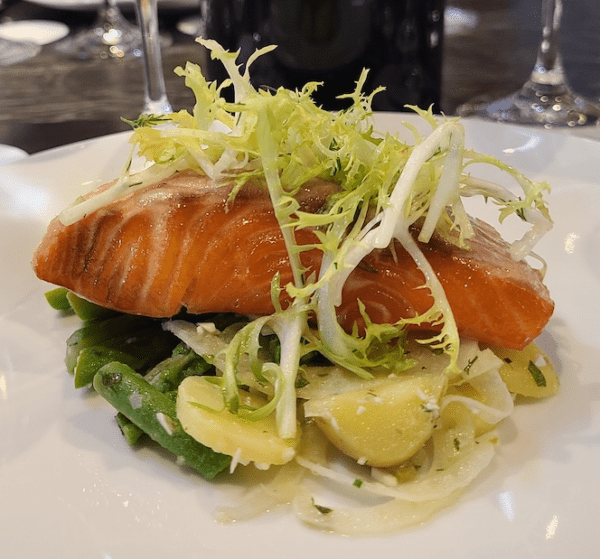
Both wines offered something different for the ocean trout. The Alexandre Fefeu Petit Chablis acidity and body matched the similar intensity of flavour of the ocean trout. Balanced. While the Domaine Servin Chablis was a richer wine with riper fruit flavours that brought out the richness in the ocean trout.
Domaine de l’Enclos Chablis 2022 – A bright, clear, deeper lemon colour. Light tropical fruit nose, plus touches of honey and toast. Dry, with a round mouthfeel. High acidity but quite fruity. Tart tropical fruit flavours along with some toastiness. Bright flavours. Some acidic prickle in your mouth. Medium-plus length. Quality!
Simonnet – Febvre Chablis Premier Cru Mont de Milieu 2020 – A bright, clear deeper lemon colour. Light intensity but deeper citrus aroma, plus a touch of flint and honey. Dry, with a silky smooth, lighter mouthfeel. Light flintiness, citrus, pineapple, and apple flavours. Medium-plus length with some bitterness on the finish.
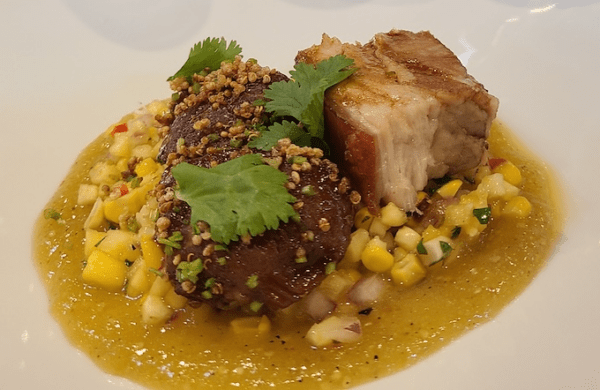
The pork cheek falls apart and has strong cilantro flavour. This matched nicely with the Domaine de l’Enclos Chablis. But the acidity was a bit too strong with the pork belly. The acidity of the Simonnet – Febvre Chablis Premier Cru Mont de Milieu worked well with both the pork cheek and the pork belly. I enjoyed the fattiness and crispiness of the pork belly with this wine. The fuller body of this wine made a bit better match.
Jean-Paul & Benoit Droin Hommage a Louis, Chablis Grand Cru 2021– A deeper, bright lemon colour, light but pretty aromas of white flowers and pineapple. Medium body with a lean mouthfeel. Higher acidity. Citrus, pepperiness, toastiness, and stony minerality on the palate. Medium-plus length with some bitterness on the finish. Quality.
Samuel Billaud Chablis Premier Cru Montmains 2021– A lighter lemon colour with green tint. Light stone fruit aromas. Medium body, lightly round and a light mouthfeel. Tart citrus and some bitterness on the palate. Also quite mineral.

I mainly compared the Brie and Comte cheeses with these two wines. The Brie made a complementary pairing to the Jean-Paul & Benoit Droin Hommage a Louis, Chablis Grand Cru, but only okay with the Comte. The Samuel Billaud Chablis Premier Cru Montmains was the exact opposite, being a better pairing with the Comte cheese.
Thank you to Mark Shipway for educating us about Chablis, for L’Abbatoir for hosting and providing the paired dishes, and to the Bureau Interprofessionnel des Vins de Bourgogne for supplying materials and (some) of the Chablis wines.
Twitter, threads & Instagram: @mywinepal
Notes by Karl Kliparchuk, media invitation MyVanCity. Images: Karl Kliparchuk A complimentary invitation was supplied by Nikolas Perez, IVSA.

